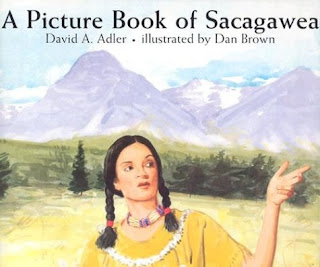 |
| Marushka bringing two apples as she was ordered Picture Source: Google Search |
Marushka and the Month
Brothers is a picture book about a young girl named Marushka, her stepmother
and stepsister Holena. As in the classic Cinderella story, Marushka is forced
to do all of the work. She obediently does so, even when commanded to find violets, strawberries, and apples in the middle of winter. When searching, she
sees a light in the distance where the Month Brothers are gathered around a
fire. The Month Brothers consist of every month of the year. She asks for the
violets, strawberries, and apples, and her wishes were granted. Thus, when
returning home the third time with the apples, it was not enough and in greed,
Holena ventures out to find more. To her surprise she also saw the light where
the Month Brothers were warming themselves by the fire. However, they were not
as kind to her as they were with Marushka and in one big breath, Brother
January blew her away, never to be seen again.
In despair, the stepmother went searching for Holena, and
also was never seen again. Hence, Marushka was no longer troubled by her cruel
stepmother and stepsister, as they were no more. However, Marushka was never
alone, because “throughout the long, cold winters, Brother January fills
Marushka’s cottage with friends. They sit around her stove and laugh, sing
songs, and tell stories in the warmth of Marushka’s smile,” a smile that could
thaw a January day (Sturges, 1996).
Marushka and the Month
Brothers is a Czechoslovakia and Slovakian folktale. It resembles a Cinderella
story, therefore, it can be called a fractured fairytale. The illustrations in the picturebook are full
page and colorful, and appear to have been created in pastels or
watercolor, or both. The theme is about being kind no matter what the circumstances, and the text is easy to read and understandable by kindergartner’s
through 3rd grade. The teacher could use this story as a comparison
to the classic Disney Cinderella and ask the students what were the differences
they noticed. Another lesson could be for the students to name the 12 Month
Brothers, as they were named after each month of the year.
Reader Response
1. Did Marushka's stepmother have a name?
2. What were the three items that the stepmother demanded Marushka
find and bring back home?
Although a short book, I enjoyed the implicit lesson being
told – to always do the right thing no matter what the circumstances.
Additionally, having a smile like Marushka would
make everyday tasks much more pleasant, while making the person much more
beautiful.Reference
Sturges, P. (1996). Marushka and the Month Brothers. New York: North-South Books, Inc.






